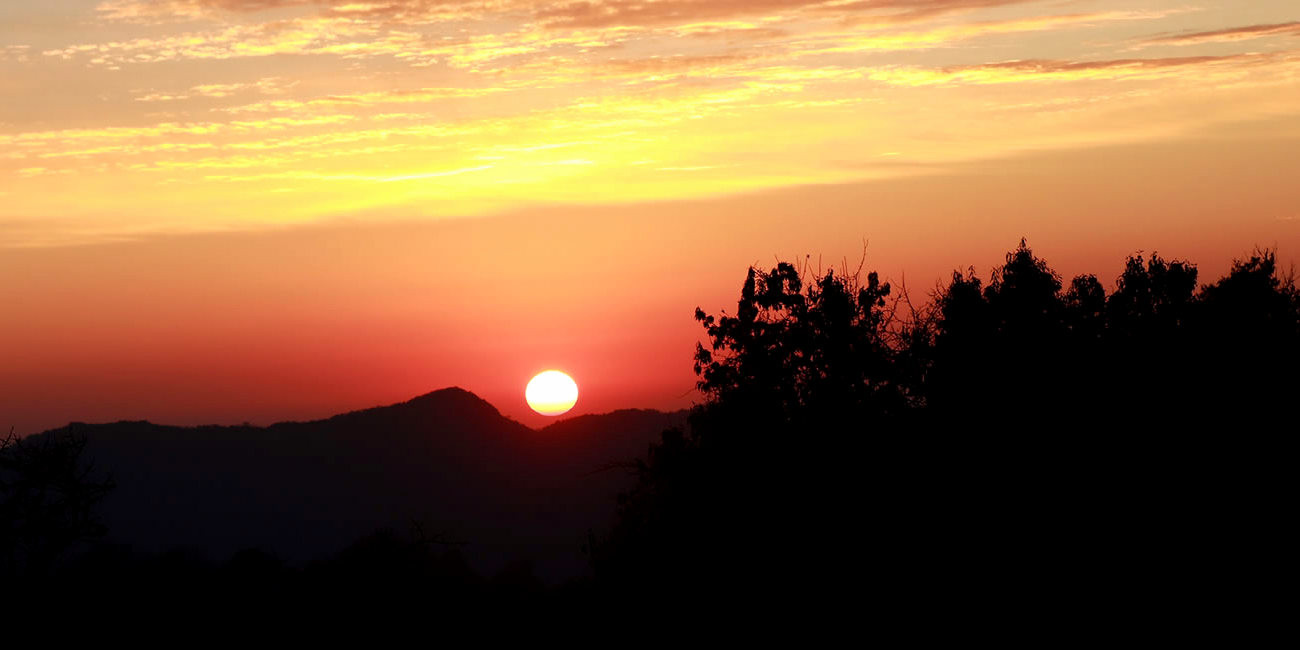Poon Hill Sunrise
The Poon Hill Sunrise experience is one of the most sought-after and mesmerising natural spectacles in Nepal. Nestled in the Annapurna region, Poon Hill stands at an altitude of approximately 3,210 metres and offers stunning panoramic views of the Himalayan ranges.
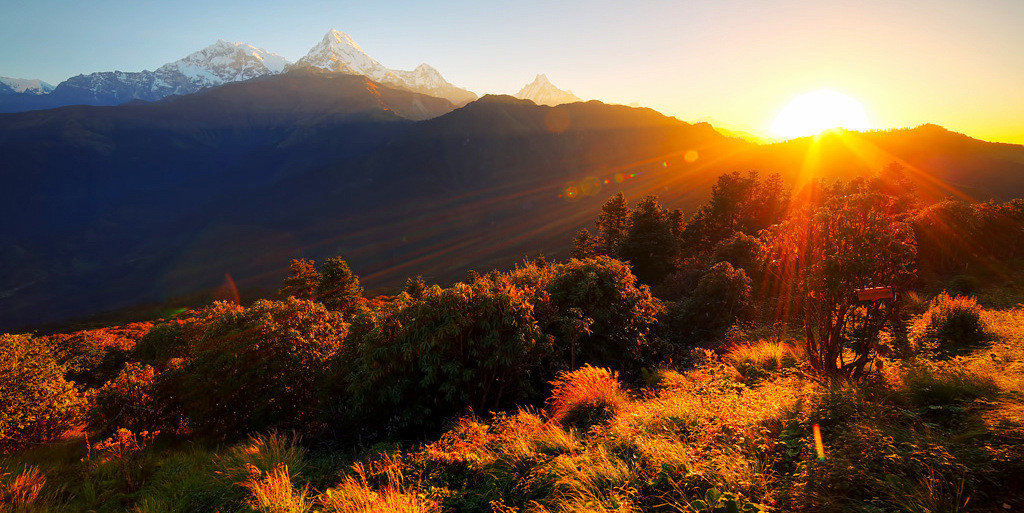
What Makes Poon Hill Sunrise Special?
-
Spectacular Panoramic Views: As the sun rises, it illuminates the peaks of the Annapurna and Dhaulagiri ranges, creating an extraordinary play of light and shadow over the snow-clad mountains. The view includes several high peaks, such as Annapurna South, Annapurna I, II, III, IV, Dhaulagiri, Lamjung Himal, Gangapurna, and Manaslu ranges.
-
Accessible Trekking Route: The Poon Hill trek is known for being relatively easy compared to other high-altitude treks in Nepal. It's often chosen by beginners or those who have limited time but still want to experience the beauty of the Himalayas.
-
Cultural Experience: The trek to Poon Hill passes through beautiful Nepalese villages, offering a glimpse into the local culture and lifestyle. Trekkers can interact with the Gurung and Magar communities, known for their hospitality and rich cultural heritage.
-
Biodiversity: The trail to Poon Hill goes through lush forests of rhododendron and bamboo, especially beautiful in the spring when the rhododendrons are in bloom.
-
Photography: For photography enthusiasts, Poon Hill offers some of the most photogenic sunrise views, with the changing colours of the sky and the golden hue of the sun reflecting off the snow-capped peaks.
A visit to Poon Hill is more than just a trek; it's an immersive experience combining natural beauty, cultural richness, and a sense of accomplishment. Whether you're a seasoned trekker or a beginner, the Poon Hill Sunrise is a must-add to your Himalayan adventure list.
Nagarkot Sunset and Sunrise
Nagarkot, a serene hilltop located near Kathmandu Valley in Nepal, is celebrated for its Nagarkot Sunset and Sunrise views. This quaint town provides a peaceful escape with one of the broadest views of the Himalayas in the Kathmandu valley, including Mount Everest as well as other peaks of the Himalayan range of eastern Nepal.
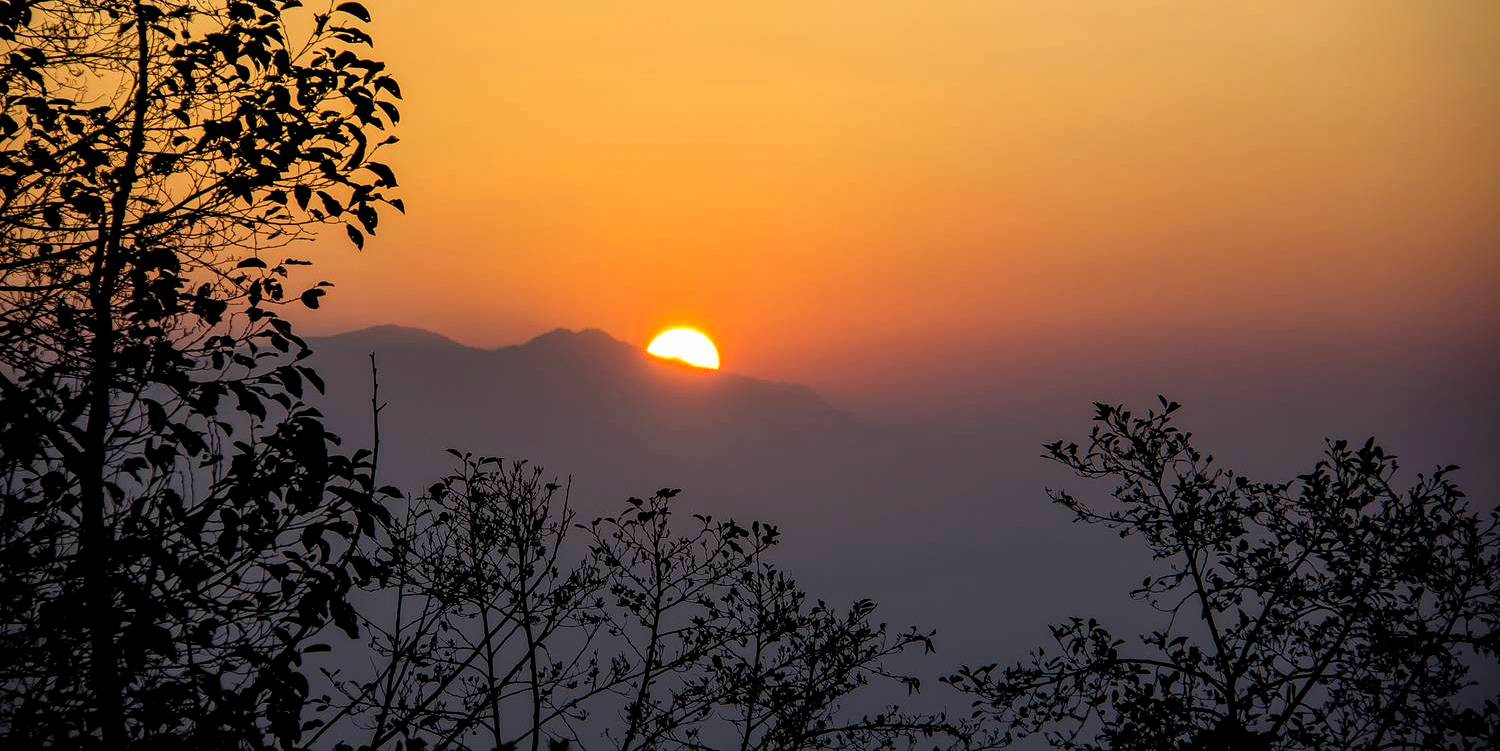
Why Nagarkot is Famous for Sunrise and Sunset
-
Panoramic Himalayan Views: Nagarkot offers a stunning panoramic view of the Himalayas. At sunrise, the first rays of the sun light up the mountains, turning them from a sleepy grey to a dazzling array of oranges, reds, and golds. Similarly, the sunset paints the sky in vivid hues, providing a breathtaking backdrop to the silhouetted mountains.
-
Accessibility: One of Nagarkot's biggest draws is its proximity to Kathmandu, making it an easy destination for both short trips and overnight stays. It's an ideal spot for those who wish to experience the beauty of the Himalayas without embarking on a strenuous trek.
-
Serene Atmosphere: The peaceful surroundings of Nagarkot provide a tranquil environment. It's a perfect place for relaxation and contemplation, away from the hustle and bustle of city life.
-
Cultural Experience: The area around Nagarkot is dotted with quaint villages and terraced fields, offering a glimpse into rural Nepalese life. Visitors have the opportunity to experience the local culture and lifestyle.
-
Photography Opportunities: For photography enthusiasts, both the sunrise and sunset provide phenomenal opportunities to capture the majestic Himalayan range in different lights and moods.
Tips for Visitors
-
Stay Overnight: For the best experience, consider staying overnight. Many hotels and resorts in Nagarkot are strategically located to offer the best views right from your window.
-
Check Weather Forecasts: The visibility of the mountains can be highly dependent on weather conditions, so it's wise to check the forecast before planning your trip.
-
Bring Warm Clothing: Mornings and evenings can be quite chilly, especially outside of the summer months, so dressing in layers is recommended.
Whether you're a nature lover, a photographer, or simply someone in search of tranquilly, the Nagarkot Sunset and Sunrise offer an unforgettable experience. Its ease of access from Kathmandu combined with the spectacular Himalayan backdrop makes it a must-visit destination in Nepal.
Kala Patthar Everest Sunrise View
Kala Patthar, located in the Everest region of Nepal, is widely regarded as one of the best vantage points for a breathtaking view of Mount Everest, especially at sunrise. The name "Kala Patthar" translates to "black rock" in Nepali, and it stands at an impressive altitude of about 5,644 metres (18,519 ft).
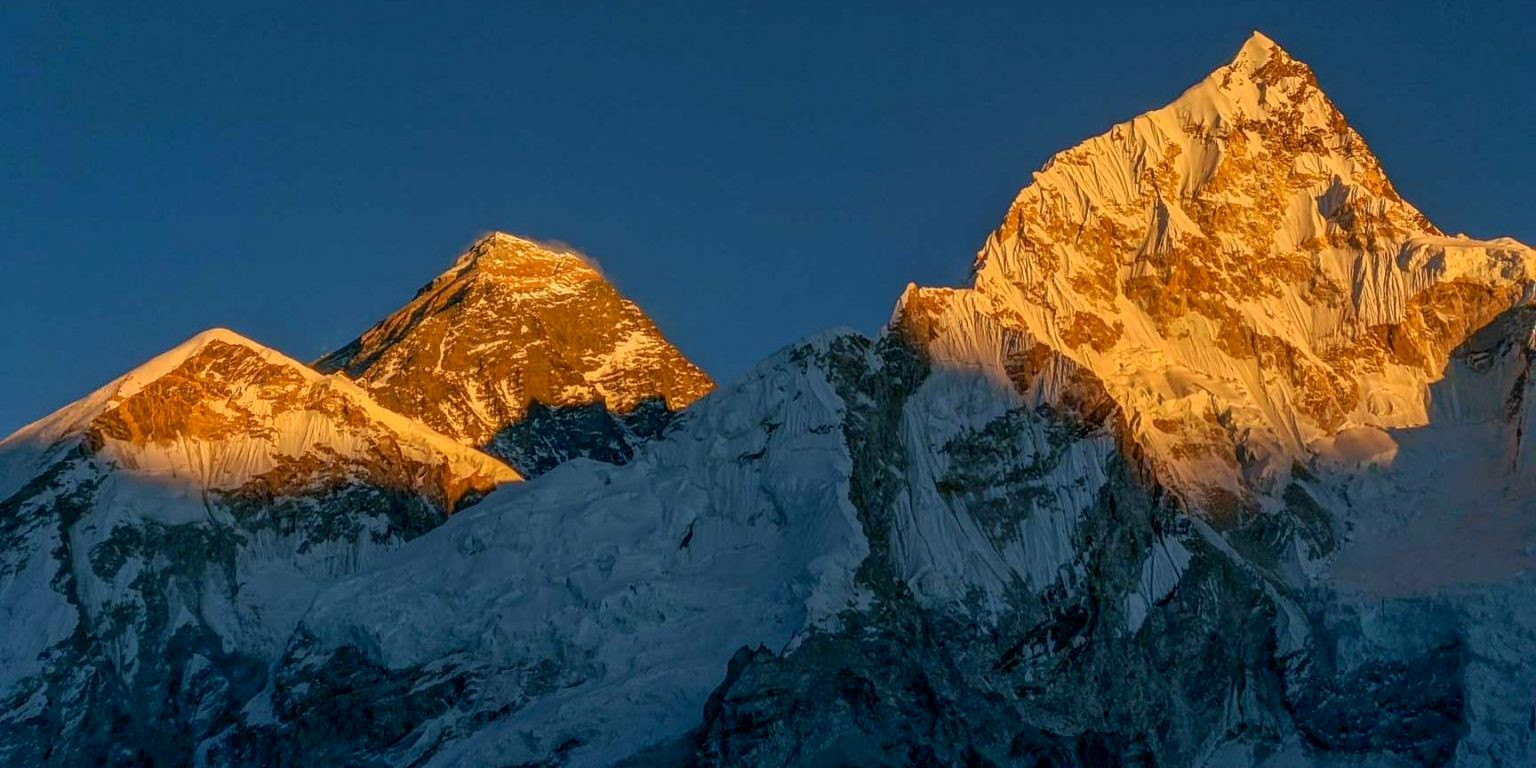
Significance of Kala Patthar for Everest Sunrise View
-
Unmatched View of Everest: Kala Patthar provides a spectacular, up-close view of Mount Everest, which is not visible from the base camp. The sunrise view from here is extraordinary, as the first light of day illuminates the world's highest peak and its neighbouring giants.
-
Panoramic Himalayan Vista: From the summit of Kala Patthar, you can witness a 360-degree panoramic view of some of the highest mountains in the world, including Nuptse, Changtse, and Lhotse.
-
The Trek Experience: The journey to Kala Patthar is as remarkable as the destination itself. Trekkers traverse through the iconic Everest Base Camp trek route, experiencing unique Sherpa culture, diverse landscapes, and stunning Himalayan scenery.
-
Photography Opportunities: For photographers, the Kala Patthar Everest Sunrise View is a dream. The interplay of light and shadow over the snowy peaks creates a surreal landscape.
Preparing for the Trek
-
Acclimatisation: Given the high altitude, proper acclimatisation is essential to prevent altitude sickness.
-
Physical Fitness: The trek is demanding, requiring a good level of physical fitness.
-
Guided Expedition: It's advisable to undertake this trek with experienced guides, as the terrain can be challenging and weather conditions unpredictable.
The Kala Patthar Everest Sunrise View is a once-in-a-lifetime experience for many. It's not just about witnessing the sunrise but also about the journey through some of the most stunning landscapes on Earth. For those who dream of seeing Mount Everest up close, Kala Patthar is an unparalleled destination.
Sarangkot Sunrise
Sarangkot, a renowned vantage point near Pokhara in Nepal, is famous for its spectacular sunrise views over the Himalayan ranges, particularly the Annapurna Massif. Perched at an altitude of approximately 1,600 metres (5,249 feet), Sarangkot offers a panoramic and breathtaking view of the surrounding mountains and valleys.
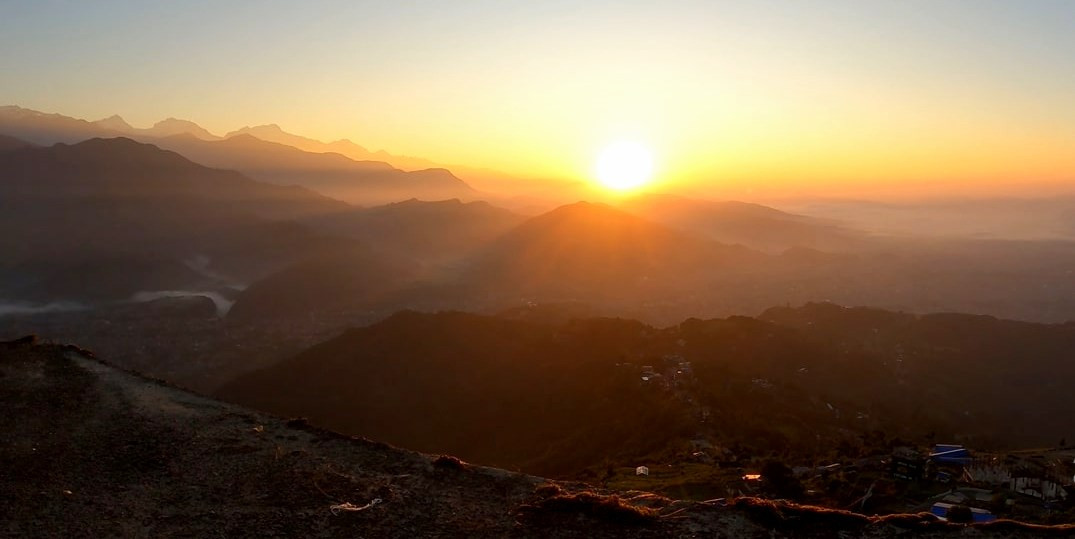
Why Sarangkot Sunrise is a Must-See
-
Stunning Himalayan Panorama: The primary allure of Sarangkot is the magnificent view of the sun rising over the Himalayas, including peaks like Annapurna, Dhaulagiri, and Machhapuchhre (Fishtail).
-
Accessibility: Unlike other high-altitude viewpoints in Nepal, Sarangkot is easily accessible from Pokhara, making it a popular destination for all types of travellers, including families and those with limited time.
-
Diverse Landscape Views: In addition to the mountain views, visitors can enjoy the scenic beauty of the Pokhara Valley and the charming Phewa Lake, especially in the early morning light.
-
Adventure Activities: Sarangkot is also a hub for adventure sports, particularly paragliding. The experience of gliding over the valley with the Himalayas in the backdrop, especially after enjoying the sunrise, is exhilarating.
-
Cultural Insight: The area around Sarangkot is dotted with traditional villages and terraced fields, offering a glimpse into the local culture and rural life in Nepal.
Tips for Visitors
-
Early Start: To catch the sunrise, you'll need to start early in the morning. It's advisable to check the sunrise time and plan accordingly.
-
Warm Clothing: Mornings in Sarangkot can be chilly, especially outside of the summer months, so it's essential to dress warmly.
-
Accommodation: There are various accommodation options in Sarangkot itself, ranging from basic lodges to more comfortable hotels, allowing visitors to stay overnight and catch the sunrise without the early travel from Pokhara.
The Sarangkot Sunrise is not just a natural spectacle but a holistic experience combining natural beauty, adventure, and cultural richness. It's a must-visit destination for those travelling to Nepal, offering one of the most accessible and yet striking views of the Himalayas at dawn.
Manungkot Viewpoint Nepal
Manungkot, a relatively lesser-known gem in the Lamjung district of Nepal, is gaining popularity for its stunning sunrise and sunset views. This tranquil spot offers a unique and serene experience, away from the more crowded tourist destinations.
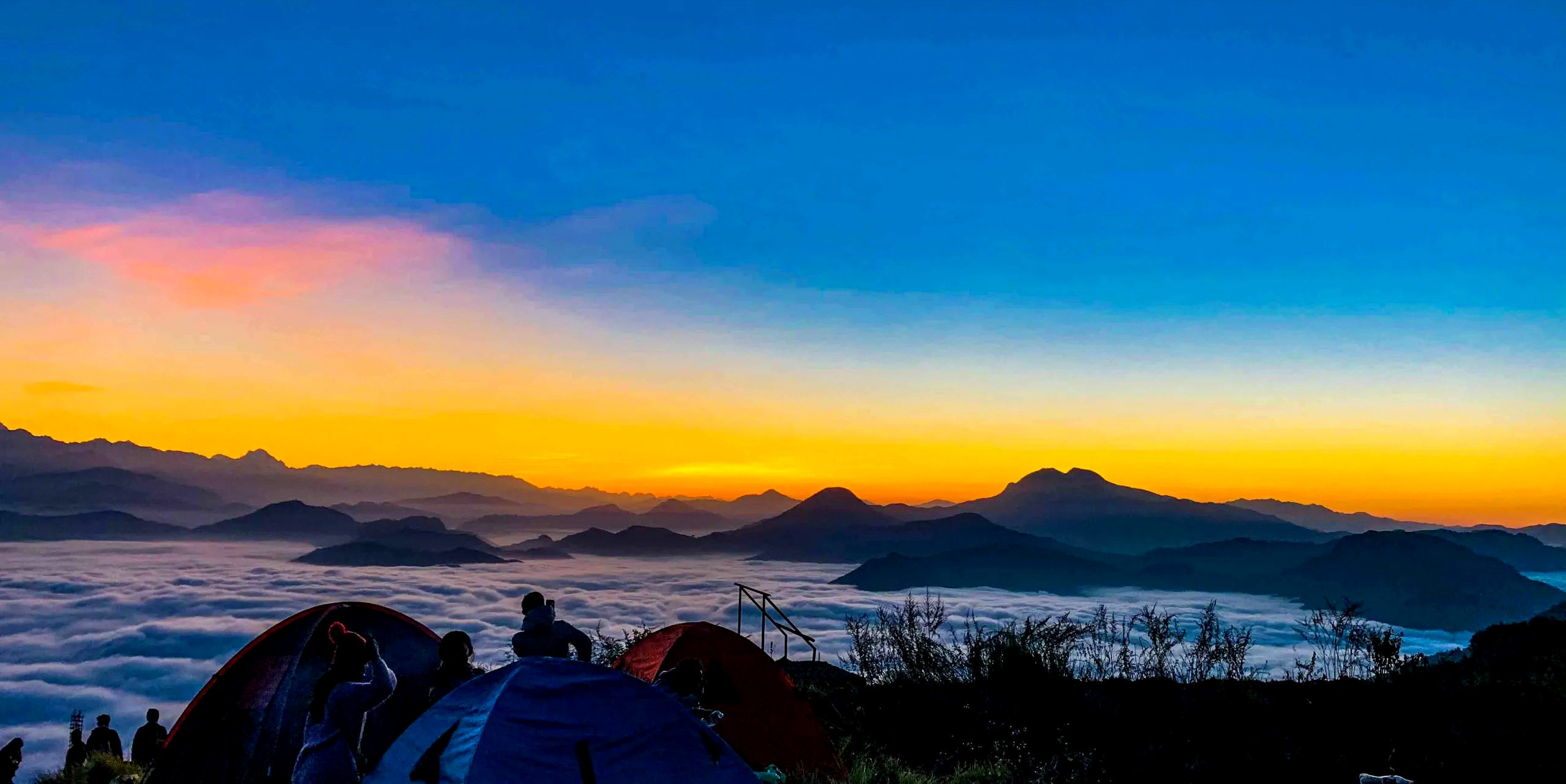
Unique Appeal of Manungkot Viewpoint
-
Breathtaking Mountain Views: Manungkot provides a magnificent panoramic view of the Himalayan range, including the Annapurna and Manaslu peaks. The sunrise from this viewpoint is particularly striking, with the first rays of the sun illuminating the snow-capped mountains in a golden hue.
-
Peaceful Atmosphere: Unlike some of the more frequented spots in Nepal, Manungkot offers a peaceful and uncrowded environment, perfect for those seeking solitude and a close connection with nature.
-
Cultural Richness: The journey to Manungkot passes through traditional Nepalese villages, offering a glimpse into the local culture and an opportunity to experience the warm hospitality of the Nepalese people.
-
Ideal for Photography: For photography enthusiasts, the natural beauty of Manungkot, with its changing colors during sunrise and sunset, provides an excellent opportunity for capturing stunning landscape shots.
-
Accessibility: While not as well-known as some other viewpoints, Manungkot is relatively accessible, making it a feasible destination even for those on a tighter schedule.
Tips for Visitors
-
Stay Overnight: To fully experience the sunrise, consider staying overnight in the area. There are local homestays and guesthouses available for a comfortable and authentic experience.
-
Warm Clothing: The early mornings and evenings can be cool, so it's advisable to bring warm clothing, especially outside of the summer months.
-
Local Guides: Engaging a local guide can enhance the experience, providing insights into the local culture and ensuring the best spots for viewing are reached.
Manungkot Viewpoint in Nepal stands as a serene and picturesque destination, ideal for those looking to enjoy nature's beauty in a peaceful setting. The stunning views of the Himalayas at sunrise and the warmth of the local communities make Manungkot a must-visit location for anyone travelling in Nepal.
Tips for Visitors
Visiting the sunrise and sunset viewpoints in Nepal can be a thrilling and unforgettable experience. However, to make the most of your trip, it's important to keep in mind some essential tips:
-
Plan Ahead: Research your destination thoroughly. Know the best times for sunrise or sunset, and understand the local weather patterns. Planning ahead also includes booking accommodations and arranging transportation in advance, especially during peak tourist seasons.
-
Acclimatization: If you're visiting high-altitude locations like Kala Patthar or Poon Hill, give your body time to acclimatise to avoid altitude sickness. This is particularly important in areas above 2,500 metres.
-
Dress Appropriately: Mountain weather can be unpredictable and often cold, especially during early mornings and evenings. Dress in layers and carry warm clothing, including hats, gloves, and thermal wear. Good-quality hiking boots are a must for trekking.
-
Stay Hydrated and Well-Nourished: High altitudes can lead to quicker dehydration and fatigue. Drink plenty of water and eat balanced meals. Carry snacks like energy bars or nuts for quick energy boosts.
-
Respect Local Customs: Many places in Nepal have rich cultural traditions. Be respectful of local customs and traditions. This includes dressing modestly in villages and religious sites.
-
Hire Local Guides: Especially in less commercialised areas like Manungkot, local guides not only offer valuable insights into the region but also contribute to the local economy.
-
Photography Etiquette: While capturing beautiful landscapes, be mindful of the local people and their privacy. Always ask for permission before taking photos of people or private property.
-
Travel Insurance: It's advisable to have travel insurance that covers high-altitude trekking and emergency evacuation, especially if you're trekking in remote areas.
-
Pack Essentials: Carry a map, a compass or GPS, a first-aid kit, a flashlight or headlamp, a whistle, and a small toolkit. For high-altitude treks, oxygen cylinders and altitude sickness medication may be necessary.
-
Leave No Trace: Preserve the natural beauty of the places you visit. Carry back all your trash and avoid disturbing wildlife and natural habitats.
By following these tips, you can ensure a safer, more enjoyable, and respectful experience while exploring the magnificent sunrise and sunset points in Nepal.
Health and Safety
When visiting the best sunrise and sunset viewpoints in Nepal, prioritising health and safety is crucial. Here are key considerations to ensure a safe and healthy experience:
Altitude Sickness
-
Acclimatisation: Give your body time to adjust to higher altitudes. This is especially important in places like Kala Patthar. A gradual ascent is key.
-
Recognise Symptoms: Be aware of altitude sickness symptoms, including headaches, nausea, and dizziness. Seek immediate medical attention if symptoms persist or worsen.
Physical Fitness
-
Pre-Trip Fitness: Engage in physical preparation before your trip. Cardiovascular exercises, hiking, and strength training can be beneficial.
-
Know Your Limits: Don't push yourself too hard, especially at high altitudes. Listen to your body and rest when needed.
Hydration and Nutrition
-
Stay Hydrated: Drink plenty of water to avoid dehydration. Avoid or limit alcohol consumption, as it can dehydrate you and worsen altitude sickness.
-
Balanced Diet: Eat balanced meals rich in carbohydrates for energy. Carry snacks, like energy bars for quick refuelling.
Weather Considerations
-
Appropriate Clothing: The weather in the mountains can change rapidly. Dress in layers, carry a waterproof jacket and use sun protection.
-
Check weather forecasts: Be aware of the weather conditions for your trekking days. Avoid trekking during bad weather.
Medical Preparations
-
First-Aid Kit: Carry a basic first-aid kit with essential items like bandages, antiseptics, pain relievers, and altitude sickness medication.
-
Travel Insurance: Ensure you have travel insurance that covers high-altitude trekking and emergency evacuation.
Safety Measures
-
Hire a Local Guide: Especially for less travelled routes, a local guide can provide valuable insights and ensure you stay on the safe path.
-
Inform Someone: Always let someone know your itinerary and expected return time.
Environmental Awareness
Local Etiquette and Customs
- Cultural Sensitivity: Respect local customs and traditions. Dress modestly and ask permission before photographing people.
Emergency Preparedness
- Know Emergency Contacts: Have a list of emergency contacts, including local rescue services, and know the location of the nearest medical facilities.
By adhering to these health and safety guidelines, your experience at Nepal's sunrise and sunset viewpoints can be both memorable and safe. Remember, preparation and respect for the environment and local culture are key to a successful and responsible adventure.
Travel Insurance
Travel insurance is an essential aspect of planning a trip to Nepal, especially when your itinerary includes visiting high-altitude destinations for sunrise and sunset views. Here are key points to consider when selecting travel insurance for your trip:
-
Coverage for High-Altitude Trekking: Ensure that your insurance policy covers high-altitude trekking. Some policies have altitude limits; make sure the policy covers treks to places like Kala Patthar or Poon Hill.
-
Medical and Emergency Evacuation: The policy should include comprehensive medical coverage, including treatment at local hospitals and emergency evacuation. In remote areas of Nepal, evacuation might require helicopter services, which can be expensive.
-
Trip Cancellation and Interruption: Look for a policy that covers trip cancellations or interruptions. This can include coverage for unforeseen events such as flight cancellations, illness, or family emergencies.
-
Baggage and Personal Belongings: Choose a policy that covers loss, theft, or damage to baggage and personal belongings. This is particularly important for expensive gear like cameras and trekking equipment.
-
24/7 Assistance Services: Opt for an insurance provider that offers 24/7 assistance. This service can be invaluable in emergencies, especially in a foreign country where language barriers exist.
-
Adventure Activities Coverage: If your trip includes adventure activities like paragliding in Sarangkot, make sure these activities are covered under your policy.
-
Policy Exclusions: Carefully review the exclusions section of the insurance policy. This section details what is not covered by the policy.
-
Read Reviews and Compare Policies: Read customer reviews and compare different policies to find one that fits your needs and budget.
-
Understand the Claims Process: Familiarise yourself with the claims process of your insurance. Know the necessary steps and documentation required to file a claim.
Adequate travel insurance provides peace of mind and can protect against significant financial losses during your trip. Given the nature of travel in Nepal, it’s not just a safety net; it’s an essential part of your travel planning.
Best Time for Sunrise and Sunset View Points in Nepal
The best time to witness the most spectacular sunrises and sunsets in Nepal, particularly at high-altitude viewpoints, is typically during the clear and stable weather conditions of the pre-monsoon and post-monsoon seasons. Here's a breakdown of the optimal times:
Pre-Monsoon Season (February to April)
-
Advantages: This period often offers clear skies and increasingly warmer days, making it ideal for trekking and viewing sunrises and sunsets.
-
Locations: This time is great for all major viewpoints like Poon Hill, Kala Patthar, Sarangkot, Nagarkot, and Manungkot.
-
Consideration: As spring progresses, there's a slight increase in cloud cover, but mornings usually remain clear for sunrise views.
Post-Monsoon Season (October to December)
-
Advantages: This is arguably the best time for clear skies and mountain views. The weather stabilises after the monsoon, leaving the atmosphere clean and dust-free, which enhances visibility.
-
Locations: ideal for all major viewpoints. The post-monsoon period is especially good for clear views of the Everest region from Kala Patthar and the Annapurna range from Poon Hill.
-
Consideration: Temperatures start to drop as winter approaches, especially in November and December, so adequate warm clothing is necessary.
Other Considerations
-
Winter (December to February): While the skies are clear, it can be very cold, which might not be suitable for all travellers. However, for those prepared for cold weather, this season offers some of the most stunning and crisp views.
-
Monsoon Season (June to September): generally not recommended for high-altitude treks due to rain, cloud cover, and potential for landslides. However, places like Nagarkot, being at a lower altitude, might still offer occasional clear views.
Tips for Timing Your Visit
-
Early Mornings for Sunrise: Regardless of the season, sunrises are best experienced early in the morning. This is when the skies are clearest, and the chance of cloud cover is minimal.
-
Late Afternoon for Sunset: Sunsets can be enjoyed in the late afternoon, but be aware that clouds can gather late in the day, potentially obscuring views.
-
Check Local Forecasts: Always check the local weather forecasts closer to your visit, as mountain weather can be unpredictable.
The post-monsoon period (October to December) offers the best combination of clear skies, stable weather, and good visibility for both sunrise and sunset viewing. However, the pre-monsoon spring season (February to April) is also a fantastic time, especially for those who prefer slightly warmer weather.
Nepal's array of breathtaking sunrise and sunset viewpoints offers an unparalleled experience for nature enthusiasts and adventure seekers alike. From the majestic peaks viewed from Poon Hill and Kala Patthar to the serene beauty of Nagarkot, Sarangkot, and the emerging Manungkot, each location presents a unique spectacle of nature's grandeur. These destinations not only offer visual splendour but also provide a deeper connection with the natural world, highlighting the immense beauty of the Himalayas. Whether it’s the golden hues of dawn at Poon Hill, the surreal first light on Mount Everest from Kala Patthar, or the tranquil sunset vistas from Nagarkot, each experience remains etched in memory as a moment of pure awe. The journey to these spots, infused with local culture and natural landscapes, adds to the richness of the experience. For anyone yearning to witness the majestic dance of light and colour in the sky against the backdrop of the highest peaks in the world, Nepal's sunrise and sunset viewpoints are destinations that should not be missed. They truly encapsulate the essence of the Himalayan wonder, making Nepal a top destination for capturing the most mesmerising moments of daybreak and twilight.
FAQs for Best Sunrise and Sunset View Points in Nepal
Q. What is the best time to visit Nepal for sunrise and sunset views?
A. The best time is during the pre-monsoon (February to April) and post-monsoon (October to December) seasons, as these periods typically offer clearer skies and more stable weather.
Q. Do I need to be an experienced trekker to visit these viewpoints?
A. Not necessarily. While some viewpoints, like Kala Patthar, require a good fitness level, others, like Nagarkot and Sarangkot, are easily accessible and do not require extensive trekking experience.
Q. How long does it take to trek to Poon Hill?
A. The Poon Hill trek usually takes about 4-5 days as part of the Ghorepani Poon Hill trek, which is considered a moderate trek.
Q. Is a guide necessary for these treks?
A. While not mandatory for all treks, a guide is highly recommended, especially for less experienced trekkers or for routes like the trek to Kala Patthar, as they can provide valuable insights and ensure safety.
Q. What should I pack for a sunrise or sunset trek in Nepal?
A. Essential items include warm clothing (in layers), good trekking shoes, a water bottle, snacks, a camera, sunscreen, sunglasses, and a hat. For higher altitudes, additional gear such as thermal wear, a down jacket, and possibly altitude sickness medication may be necessary.
Q. Can I see Mount Everest from any of these viewpoints?
A. Yes, Mount Everest can be seen from Kala Patthar, which offers one of the best views. On clear days, it can also be seen from Nagarkot.
Q. Are these viewpoints safe for solo travellers?
A. Generally, yes. However, solo travellers should take standard safety precautions, such as informing someone of their plans and expected return, and considering joining a group or hiring a guide.
Q. How can I respect local customs while visiting these sites?
A. Dress modestly, ask permission before taking photos of people, avoid littering, and be sensitive to local traditions and practices.
Q. What kind of accommodation is available near these viewpoints?
A. Accommodation options range from basic teahouses and guesthouses to more luxurious hotels, particularly in places like Nagarkot and near Pokhara for Sarangkot.
Q. Is there mobile connectivity at these viewpoints?
A. Connectivity can be limited in remote areas. However, places like Nagarkot and Sarangkot, being closer to cities, generally have better connectivity.
For the Nepal tour, please click here.
If you are looking for different kinds of Nepal Tours or Trekking Packages, feel free to contact us.
